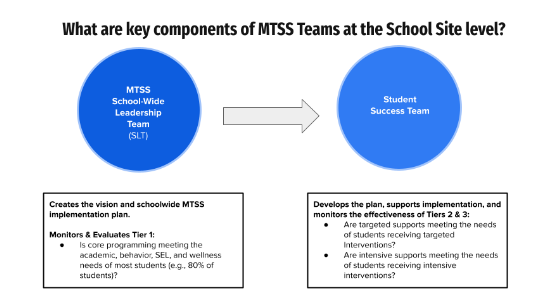MTSS school teams
MTSS teams are an essential component of a successful implementation. They should have clear structures and processes to guide decision making and meet regularly. Here are some of the reasons why MTSS teams are crucial:
- Shared leadership: MTSS teams help distribute the workload among members so that leadership is shared. This ensures that no one person bears the full responsibility, and also provides an opportunity for collaboration.
- Sustainability: With a team in place, the work can be sustainable, even if a member leaves. The processes and structures that have been established can continue without interruption.
- Evaluation and continuous improvement: MTSS teams provide the infrastructure for systemwide evaluation and continuous improvement. By regularly reviewing and analyzing data, the team can identify areas of success and areas that need improvement, and adjust their approach accordingly.
Primary functions:
- Ensure the fulfillment of assigned roles and responsibilities in support of MTSS implementation.
- Advance the goals of the MTSS team.
- Regularly communicate the importance of social and emotional learning and restorative practices throughout the school community and model SEL competencies/behavior expectations.
- Assist the team facilitator/coordinator in developing and delivering presentations about schoolwide MTSS for the school community.
- Communicate with the constituent group that the team member represents. For example, a team member who is a teacher might be responsible for communication with other teachers regarding MTSS in the classroom.
There is no fixed number of teams to have, as long as they adapt to their unique needs and situations. However, schools should think about the roles and purposes of their teams. Typically, schools should have a leadership team to supervise the implementation of MTSS and another team to spot and provide support to students who require more interventions. There may also be other teams for data analysis or family and community engagement.
MTSS School-wide Leadership Team
Members of the school’s MTSS leadership team will model SEL competencies/behavior expectations throughout the school community and work to advance the vision and mission of the MTSS team. The MTSS team should consist of representatives from each of the four pillars of MTSS, including academics, behavior, culture of belonging, and mental health.
Team members may include:
-
- MTSS Coordinator: Oversees the MTSS team and ensures effective implementation, serving as a liaison with other school staff.
- Administrator: Provides administrative expertise and support to the work of the MTSS team.
-
- Special education teachers: Provide specialized instruction and support for students with disabilities, working closely with classroom teachers and the MTSS team.
- General education teachers: Provide classroom expertise in effective first instruction and implementation of Tier 1 strategies.
- Curriculum specialist: Provides expertise in coaching and supporting teachers in the adoption of instructional strategies.
- School psychologists: Provide expertise in areas such as behavior management, assessment, and intervention planning, and participate in data analysis meetings.
- Behavior specialists: Provide support for students with behavior issues, developing intervention plans, and coaching and support.
- Speech and language pathologists: Provide support for students with communication disorders, developing individualized intervention plans with the MTSS team.
- Data coordinators: Collect and analyze data on student progress to inform intervention decisions, working closely with the MTSS team.
- Family engagement specialists: Work with parents and families to involve them in the MTSS process, providing information and facilitating communication with the MTSS team.
- Student representatives: Provide student voice and feedback to the MTSS team.
Student Success Team (SST)
As schools implement MTSS, the Student Success Team (SST) ensures that student needs are addressed at the Tier 2 level. To do this, the SST uses problem solving, data-driven decision making, targeted interventions, and progress monitoring, with early intervention as a core aspect of general education. More specific information is available in the Student Success Team (SST) Handbook.


